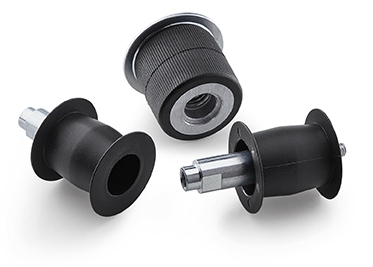Introduction and Application of Interchangeable Roller
Roller is a cylindrical roller used in conveyor belts to transport various materials. Rollers are made of different materials such as steel, plastic, aluminum, and ceramic and are available in different sizes and diameters. These tools keep the conveyor belt in place during its movement and prevent it from sagging. In fact, rollers carry materials to the desired destination by moving the conveyor belt. Among the different types of rollers, we can mention the interchangeable roller. This tool is used to replace conveyor belt rollers and consists of a metal frame, a hydraulic jack, and a control system.
Application of Interchangeable Roller
The main application of the interchangeable roller is in conveyor belts. These types of rollers are designed so that the bearings can be easily replaced if they become damaged or worn. This allows the conveyor belt to continue operating without the need to replace the entire roller.
Where is the Interchangeable Roller Located?
The interchangeable roller is used in place of the traditional roller in conveyor belts. Traditional rollers are usually permanently attached to the conveyor belt frame, but interchangeable rollers can be easily removed and replaced. These rollers are placed in two main locations on the conveyor belt:
1. In the frame of conveyor belts that carry abrasive or corrosive materials: This is because interchangeable rollers can be easily replaced.
2. Under the conveyor belt between the return and carry rollers: This is usually done on conveyor belts that require frequent roller replacement, as interchangeable rollers can be replaced without the need to turn off the conveyor belt.
In fact, the location of the interchangeable roller depends on several factors:
-
If the conveyor belt is responsible for carrying abrasive or corrosive materials, these rollers should be installed in the conveyor belt frame.
-
If the conveyor belt operates at high speed, this tool should be installed under the conveyor belt to prevent vibration and oscillation of the conveyor belt.
-
Also, if the conveyor belt requires frequent maintenance, the interchangeable rollers should be placed under the conveyor belt for easy replacement.
Features and Specifications of an Interchangeable Roller
The specifications of an interchangeable roller can be classified into two groups:
General Specifications:
-
Diameter: The diameter of the interchangeable roller depends on the type of conveyor belt and the type of material being conveyed. Larger diameter rollers are suitable for conveyor belts with higher capacity and heavier materials.
-
Length: The length of the interchangeable roller depends on the width of the conveyor belt.
-
Material: Interchangeable rollers are usually made of steel, plastic, or ceramic.
-
Bearing: Interchangeable rollers can be with or without bearings. Rollers with bearings are suitable for conveyor belts that operate at high speed.
Technical Specifications:
-
Load capacity: The load capacity of the interchangeable roller depends on the type of roller and its material.
-
Speed: The speed of the interchangeable roller depends on the type of roller and its bearing.
-
Corrosion resistance: Interchangeable rollers must be resistant to corrosion.
-
Wear resistance: Interchangeable rollers must be resistant to wear.
-
Temperature resistance: Interchangeable rollers must be resistant to the ambient temperature.
Structure of Interchangeable Roller
Interchangeable rollers are significantly different in structure and quality from conventional rollers. Due to advantages such as longer life, easier maintenance, and the ability to replace bearings, these types of rollers are widely used in various industries.
Components of Interchangeable Roller
The interchangeable roller consists of various components, each of which has a function. Here is a list of these components:
Shell:
The outer shell of the roller is made of different materials such as steel, plastic, or ceramic. The functions of this section are as follows:
-
Protecting internal components
-
Creating a smooth surface for the conveyor belt to move
-
Withstand the load of the conveyed materials
Shaft:
The shaft is a rod that passes through the shell and connects the roller to the conveyor belt frame. The functions of the shaft are as follows:
-
Roller rotation
-
Transferring the load of the conveyed materials to the conveyor belt frame
Bearing:
Bearings are bearings that are located inside the shell and on the shaft and help the roller rotate smoothly. The functions of the bearing are as follows:
-
Friction reduction
-
Increase roller life
-
Reduce noise and vibration of the roller
Seal:
Seals are made of different materials such as rubber or felt and are located at the edges of the shell. The functions of the seal are as follows:
-
Preventing dust and dirt from entering the roller
-
Prevent lubricant leakage
-
Increase roller life
In addition to the main components, interchangeable rollers may also have other components:
-
Washer: The washer is used to prevent direct contact between the shell and the shaft.
Application of Interchangeable Roller in Various Industries
The interchangeable roller is typically used in applications that require frequent roller replacement. Some applications of interchangeable rollers in various industries include:
-
Mining conveyor belts: Interchangeable rollers are used in mining conveyor belts to transport ore, coal, and other minerals.
-
Factory conveyor belts: Interchangeable rollers can be used in conveyor belts of manufacturing plants to transport parts, products, and raw materials.
-
Port and airport conveyor belts: They are used to transport cargo, luggage, and other items.
-
Agricultural conveyor belts: Interchangeable rollers are used in agricultural conveyor belts to transport agricultural products such as grains, fruits, and vegetables.
Advantages of Interchangeable Roller
By choosing the right interchangeable roller, you can benefit from its many advantages and significantly increase the efficiency and performance of the system. Overall, using interchangeable rollers has many economic, technical, and environmental advantages. Some of the most important advantages of using this tool are:
-
Longer life: The bearings of interchangeable rollers are of high quality and are protected from dust and moisture. Due to the timely replacement of bearings, the useful life of the roller is significantly increased.
-
Cost reduction: Replacing the bearing instead of the entire roller is more cost-effective. Because it requires less maintenance and repair, the cost of roller replacement decreases in the long run due to its longer life.
-
Reduced downtime: Replacing bearings in interchangeable rollers is quick and easy; This results in shorter production line downtime and increased efficiency and productivity.
-
Diversity and flexibility: Interchangeable rollers are available in various sizes, materials, and capacities. This variety makes them suitable for various applications and environmental conditions. Also, this tool is adjustable and customizable.
-
Compatibility with the environment: Due to the need for less roller replacement, less waste is generated, and as a result, the consumption of raw materials and energy is optimized.
Other advantages:
-
Interchangeable rollers reduce friction and noise.
-
Interchangeable rollers ensure smoother and more efficient conveyor belt movement.
-
Interchangeable rollers minimize the need for lubrication.
-
Interchangeable rollers increase the safety and efficiency of production lines.
Disadvantages of Interchangeable Roller
Interchangeable rollers, along with their many advantages, also have some limitations. Some of the disadvantages of these rollers are:
-
High initial cost: Interchangeable rollers are generally more expensive than pressed rollers. This is due to the complexity of their construction and the use of higher quality raw materials.
-
Need for expertise: Replacing internal parts of the interchangeable roller requires knowledge and technical skills. Lack of sufficient skill can lead to roller damage or conveyor belt damage.
-
Replacement time: Replacing internal parts of interchangeable rollers is more time-consuming than replacing pressed rollers. This can lead to production line downtime and financial loss.
-
Not always interchangeable: In some cases, replacing internal parts of an interchangeable roller is not cost-effective. In these cases, it is necessary to replace the entire roller, which will incur additional costs.
-
Less variety: The variety of interchangeable rollers is less compared to pressed rollers. This can make it difficult to choose the right roller for your specific needs.
-
Probability of نقص: Due to the complexity of construction, the probability of نقص in interchangeable rollers is higher than in pressed rollers. نقص in the roller can lead to conveyor belt failure and production line downtime.
-
Need for more maintenance: Interchangeable rollers, due to their more complex structure, require more periodic maintenance and lubrication. Lack of proper maintenance can lead to premature roller failure.
-
Not suitable for harsh conditions: Some interchangeable rollers are not suitable for use in harsh conditions such as high temperatures or high humidity. Choosing the wrong roller can lead to premature failure and financial loss.
Price of Interchangeable Roller
The price of the interchangeable roller is not fixed, as some factors are involved in determining it. Some of the factors affecting the price of the interchangeable roller are as follows:
-
Roller material: Roller material is one of the most important factors determining its price. Metal rollers are generally cheaper than plastic rollers. On the other hand, stainless steel rollers are the most expensive type of interchangeable rollers.
-
Roller diameter: The roller diameter also affects its price. Larger diameter rollers are generally more expensive than smaller diameter rollers.
-
Roller length: Longer rollers are generally more expensive than shorter rollers.
-
Bearing type: The type of bearing used in the roller also affects its price. Higher quality and longer life bearings are more expensive.
-
Manufacturer brand: Famous and reputable brands offer higher prices.
-
Country of manufacture: Rollers made in European and American countries are generally more expensive than rollers made in Asian countries.
-
Order quantity: Discounts are usually given for large orders.
-
Market conditions: In times of increased

